Small Cottagecore Gardens: Space-Saving Ideas for Patios, Balconies, and Tiny Yards
You’ve probably seen those dreamy cottagecore gardens on Pinterest—the ones with rambling roses, wildflower meadows, and pathways that seem to wander for miles. And maybe you’ve thought, “Well, that’s lovely, but I’ve got a balcony the size of a postage stamp.” I get it. That was me, three summers ago, staring at my 8×10-foot concrete patio with a single sad plastic pot and thinking cottagecore was just another thing my small space couldn’t have.
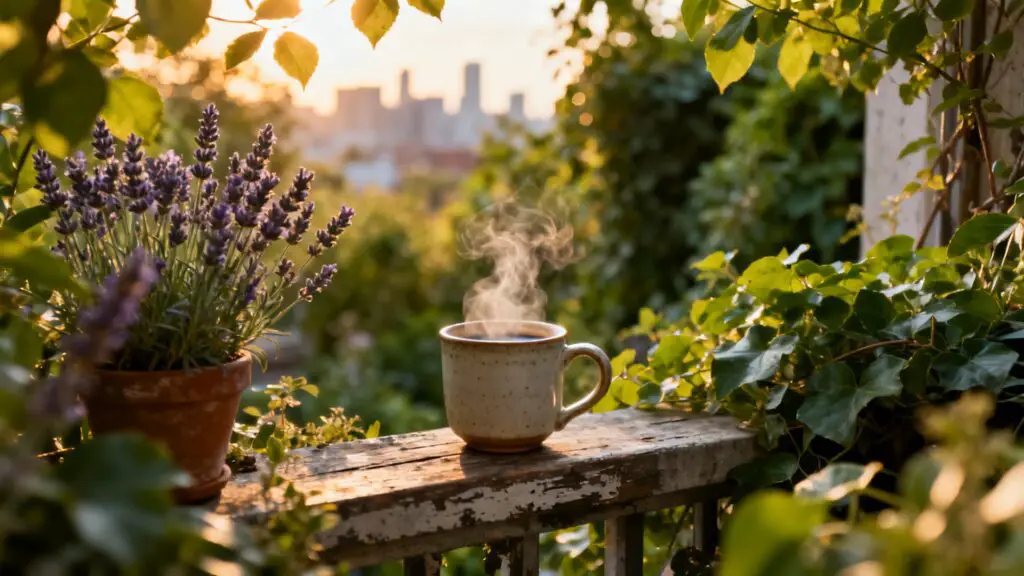
But here’s what I’ve learned: cottagecore isn’t about acreage. It’s not about having room for a potting shed or a meadow that goes on forever. It’s about atmosphere. It’s about that feeling you get when you brush past lavender and the scent follows you inside. It’s about morning coffee surrounded by greenery so dense you forget what city you live in for a minute. And that? That you can absolutely create anywhere.
I’m not sure if this is just me, but I think small cottagecore gardens might actually be more magical than big ones. There’s something about the intensity of it all—the way every inch becomes precious, the way you can smell everything at once because it’s all clustered so close. It’s less of a garden and more of a secret you’re keeping from the outside world.
So let’s talk about how to do this. Really do it, not just plonk a geranium in a pot and call it a day.
Principles for Small Cottagecore Spaces
Look, before we get into the specifics, we need to shift how we think about space. Because the biggest mistake I see people make with small gardens is trying to fit a big garden into a small footprint. They buy too many plants, cram them all in, and everything just looks cluttered and stressed.
Keep Textures Soft

Here’s what I mean. In a tiny space, hard lines feel like walls closing in. Sharp corners on furniture, rigid rows of plants, anything that feels man-made and exact—it all screams “small concrete box.” But soft textures? They blur edges. They make boundaries disappear.
Think about the difference between a metal bistro chair and one with a curved back and a cushion that sags just so. Think about the edge of a border where ferns and lady’s mantle spill over onto the gravel, softening that line between garden and path. Even the plants themselves—choose lamb’s ear over spiky yucca, choose cosmos over stiff canna lilies. It’s not just about looks; it’s about how your eye moves through the space. Soft textures invite you to look closer, to lean in, and that intimacy is what cottagecore is all about.
Use Vertical Elements

This one changed everything for me. When I finally stopped trying to arrange everything on the ground and started looking up, my balcony doubled in size overnight. And I don’t just mean hanging baskets (though we’ll get to those). I mean creating a sense of height that draws the eye upward and makes you feel enveloped.
A simple trellis with a climbing sweet pea can turn a blank wall into a scented curtain. A tall, narrow obelisk in a container gives morning glories something to do besides sprawl. Even better—mix them. Put a climber behind a trailing plant, and you’ve got this waterfall of green that starts six feet up and ends up pooling at your feet. It’s kind of like architecture, but alive.
And here’s the secret: vertical elements create micro-climates. That shady spot behind the trellis? Perfect for foxgloves that would fry in full sun. The sunny top of an obelisk? That’ll be your hottest spot, great for something Mediterranean that needs heat. You’re not just saving space; you’re creating entire ecosystems in the air.
Focus on Layering, Not Quantity
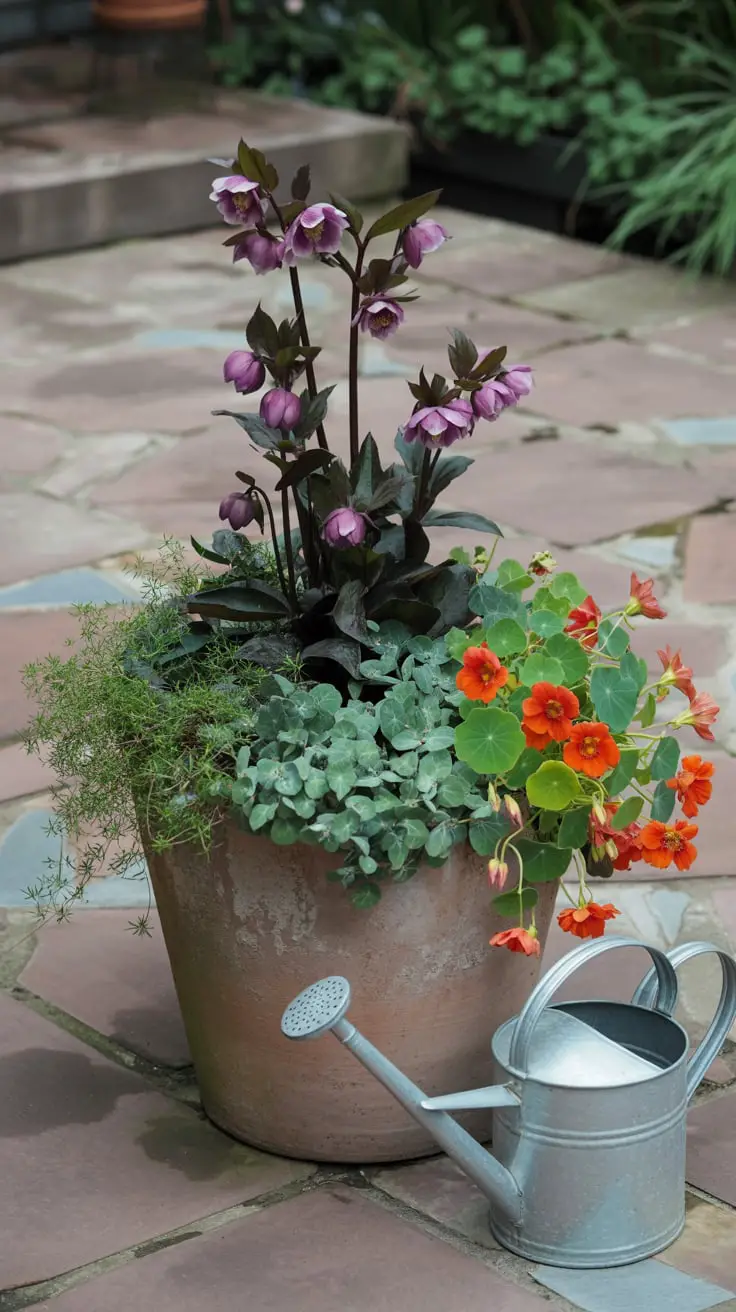
This is the big one. We all have that moment at the nursery where we want to buy one of everything. But in a small cottagecore garden, twelve plants in a single layered container will always look more abundant than twelve plants each in their own pot, scattered around.
Layering means thinking like a forest floor. Tallest plants in back or center, medium plants around them, trailers spilling over the edge. But also think about layering through time—having something blooming in early spring (hellebores), something taking over in summer (nasturtiums), and something with seedheads that looks gorgeous in frost (sedum). You’re creating depth, and depth reads as abundance.
I learned this the hard way when I bought, no joke, seventeen different plants for my tiny patio. Seventeen. It looked like a plant sale exploded. Now I have maybe eight containers, but each one is packed with three to five plants that work together. It looks like more. It feels like more. And honestly? It’s easier to care for.
Balcony Ideas
Okay, so you’re working with a balcony. Maybe it’s got a railing, maybe it’s just a slab of concrete suspended in air. Either way, you’re dealing with wind, weight restrictions, and probably some very un-cottagecore views you want to block.
Hanging Baskets That Actually Feel Wild
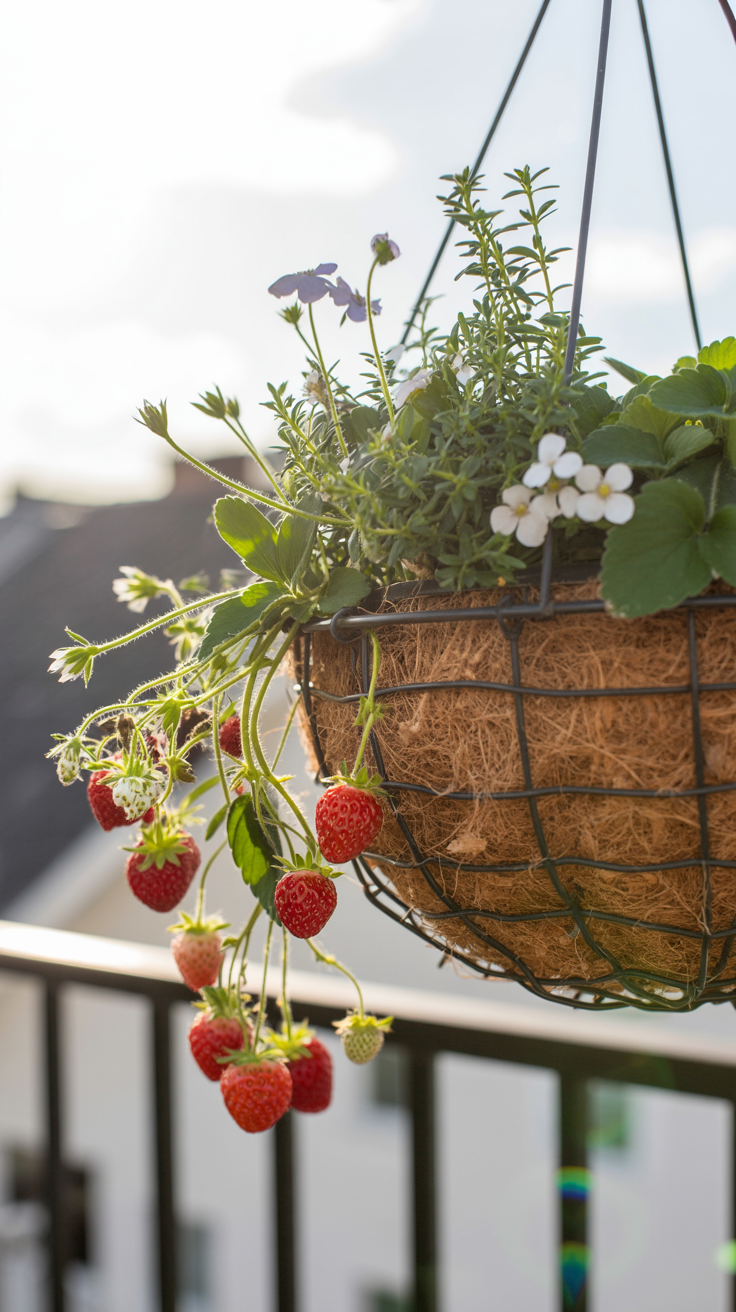
Here’s the thing about most hanging baskets—they’re too perfect. Perfectly rounded, one type of plant, that stiff moss liner. But cottagecore hanging baskets should feel like you found them growing that way in a clearing somewhere.
I use wire baskets with coir liners, but I poke holes in the sides and plant trailing things—strawberry plants, vinca, that weird little creeping thyme that smells like lemon. So you’ve got flowers on top, but also these green tendrils reaching out sideways and down. And I always, always mix edibles with flowers. Not in a “I’m being practical” way, but because there’s something so cottagecore about reaching up to pluck a strawberry while you’re sipping wine.
Weight is an issue, I know. Use lightweight potting mix—not garden soil, it’s too heavy. And here’s a trick: put a layer of those water-retaining crystals at the bottom of the liner. They swell up and hold moisture so you’re not watering twice a day in July. Because let’s be honest, if you’re anything like me, you’ll forget.
Narrow Planter Towers That Create Walls

I have this narrow balcony—maybe three feet deep—and for the longest time I couldn’t figure out how to screen out my neighbor’s air conditioning unit. Planter towers solved it. But not those pre-made ones that look like a staircase for plants. I made mine from a halved wooden pallet stood on end, with fabric pockets stapled inside.
The trick is planting things that want to be tall but not wide. Dwarf sunflowers (the ones that only get three feet), cosmos ‘Sonata’ series, snapdragons. In the top pockets, I put things that trail—creeping jenny, bacopa, that gorgeous silver dichondra that looks like tiny lily pads. Within six weeks, I had this living wall that moved in the breeze and hummed with bees.
And honestly? The bees are the point. You know that moment when you’re standing on your balcony, coffee in hand, and a bumblebee is working its way through your flowers, and you’re so close you can hear its wings? That’s the whole game. That’s cottagecore.
Climbers on Trellises That Don’t Damage Anything
Most balconies have rules. No screwing things into walls, no drilling into railings. I get it. But you can still have climbers. I use those tension rod trellises—the kind you wedge between floor and ceiling. They’re adjustable, they’re not permanent, and they give clematis ‘Betty Corning’ or morning glories something to grip.
The secret is choosing climbers that are happy in containers. Sweet peas are perfect for this. They don’t need huge pots, they smell like heaven, and you can succession-plant them every three weeks for continuous blooms. I use a whiskey barrel half (the lightweight plastic kind that looks like wood) and put three sweet pea seedlings in it with a tripod of bamboo stakes. By June, it’s this scented column that blocks my view of the parking lot completely.
But here’s what nobody tells you: you have to be ruthless with climbers. Cut them back hard when they get leggy. In a small space, a climber that’s just stems and a few leaves at the top is depressing. You want that thing dense from bottom to top. I cut my sweet peas back by a third in July, and they come back bushier and bloom like crazy through September.
Patio Ideas
Patios are weird spaces. They’re usually right next to the house, which means you’ve got overhangs creating shade, reflected heat from walls, and that feeling of being in a box. But that box feeling is actually perfect for cottagecore. We’re trying to create an enclosed, secret-garden vibe anyway.
Small Bistro Sets That Feel Collected Over Time
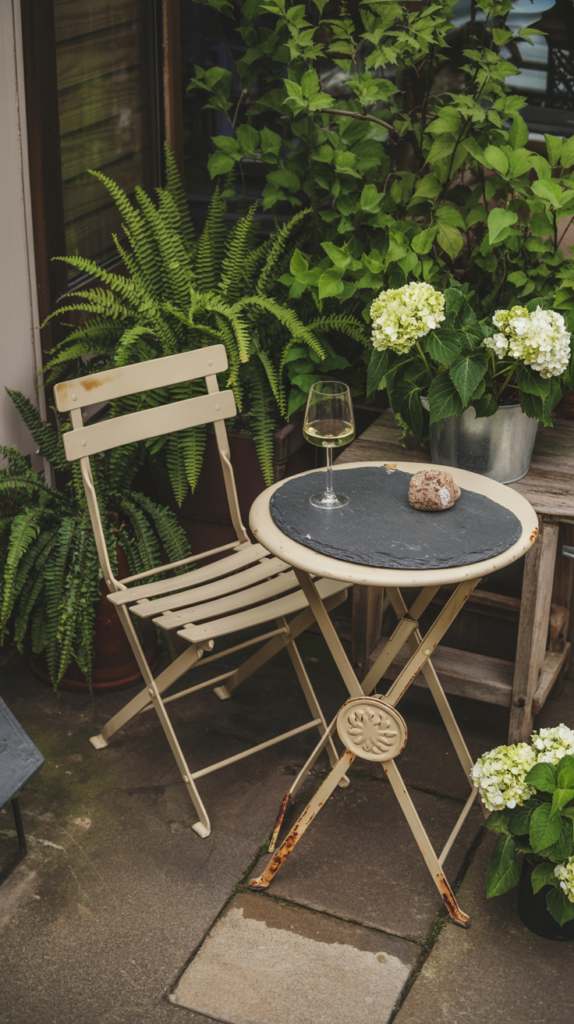
Please stop buying those three-piece patio sets that match. You know the ones—glass top table, two chairs, everything in black or dark green. They look tidy, but they don’t feel like anything. Cottagecore is about things that look like they were found, inherited, cobbled together.
I have this metal bistro chair I found at a flea market, painted it cream, and let it rust a little on purpose. The table is actually an old wooden stool I topped with a slate slab. The second chair doesn’t match at all—it’s wicker, and the weave is coming undone in one spot. I love that spot. It feels honest.
And scale matters here. A tiny table feels more generous in a tiny space than a normal-sized one. You can fit a 24-inch round table in a corner and two chairs, and it feels like a destination. A 36-inch table in the same space feels like you’re waiting for the rest of the furniture to arrive.
Container Groupings That Tell a Story
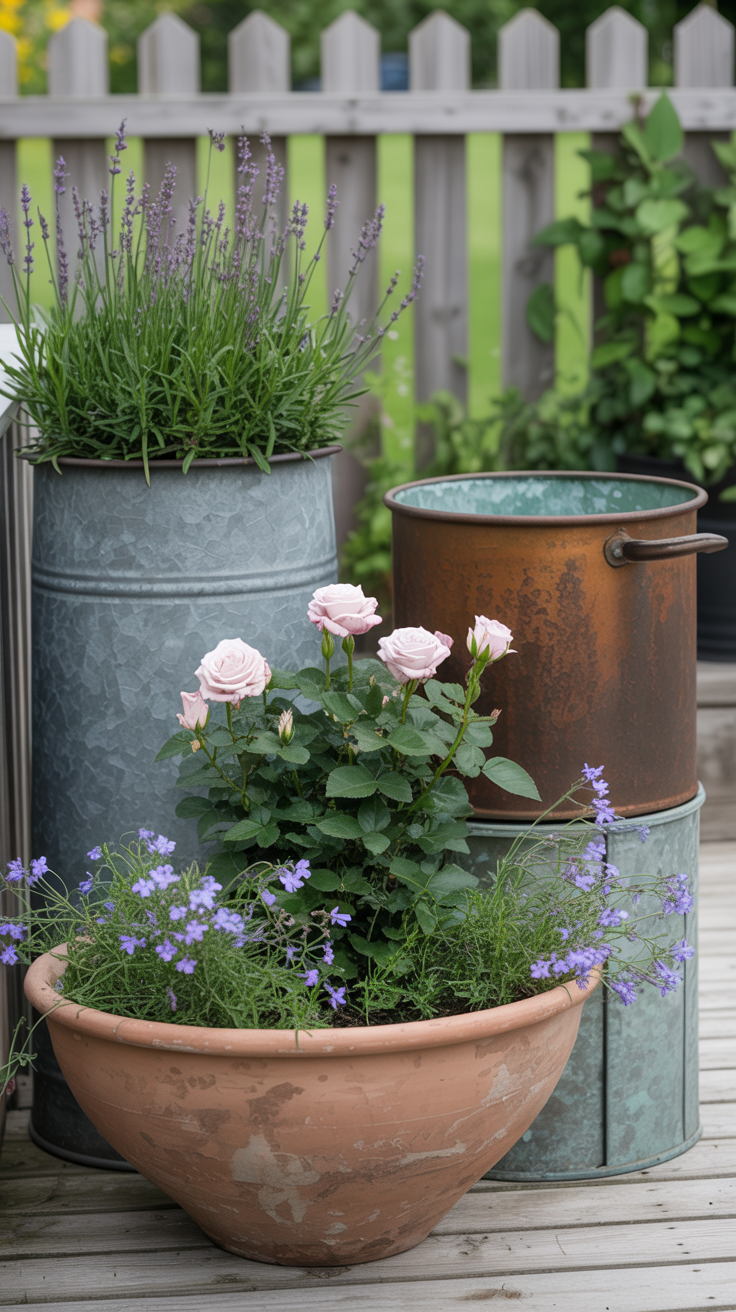
This is where the layering principle really sings. Don’t line your containers up like soldiers. Group them. Odd numbers work best—three, five, seven. Put the tallest in the back, mediums on the sides, and a low, wide one in front. But here’s the key: they should look like they’ve been there forever.
I use a mix of containers—terracotta (always, always terracotta, because it breathes), a galvanized metal tub with drainage holes drilled in the bottom, an old copper boiler that’s developing that gorgeous green patina. They don’t match, but they relate. They’re all old-looking, all slightly imperfect.
In each container, I’m thinking about that layered planting. My favorite combo: a dwarf rose (‘Winsome’ is perfect, stays two feet tall) in the center, surrounded by three lavender plants, with trailing lobelia spilling over the edge. The rose blooms in flushes, the lavender is constant, the lobelia looks like a blue waterfall from June to frost. And the smell? It’s like walking into a memory.
Mini Pergolas or Arches That Create Rooms
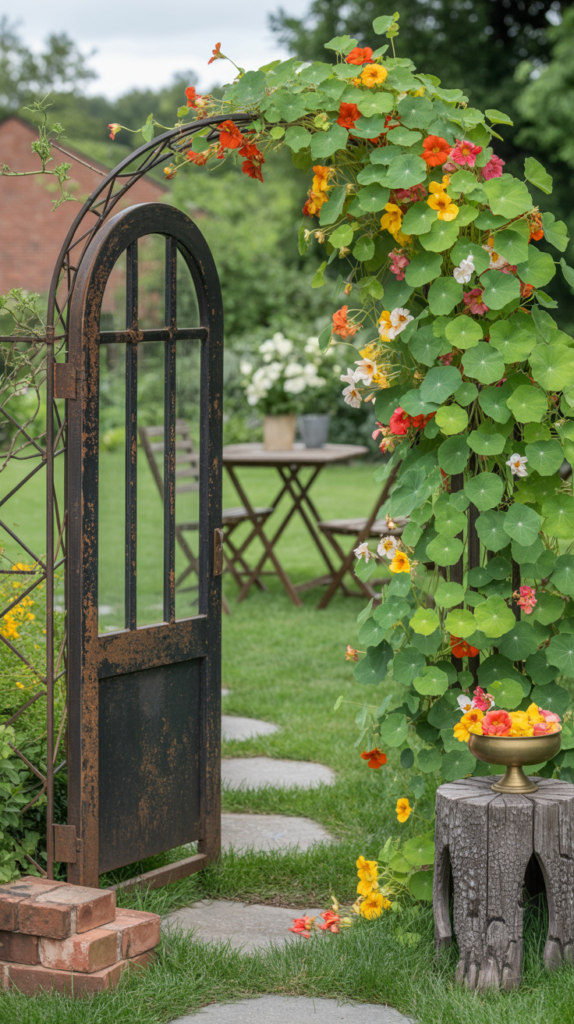
I know what you’re thinking—a pergola on a patio? But I’m talking small. Like, four feet tall small. I put up a metal garden arch (the kind that just pushes into the soil, but I weighted the feet with bricks) and grew climbing nasturtiums up it. By midsummer, it was this portal you had to walk through to get to the bistro set.
It transformed the space. Suddenly I had a “before” and an “after,” a sense of journey. And nasturtiums are perfect for this—they’re happy in poor soil, they trail as much as they climb, and you can eat the flowers. I put them in salads and feel incredibly smug about it.
But you could also do this with a simple bamboo tepee for pole beans. Three bamboo poles tied at the top, stuck in a large pot, beans planted around the edges. It’s architecture, it’s food, it’s flowers, and it makes your patio feel like a room within a room.
Tiny Yard Ideas
Now we’re talking about actual ground. Even if it’s only, say, 200 square feet. That’s enough. Honestly, it’s more than enough. My friend has a yard that’s basically the size of a two-car garage, and it’s the most magical space I’ve ever been in. Because when everything’s that close, you can smell everything at once. The honeysuckle, the roses, the damp earth after rain—it all concentrates.
Curved Borders That Trick the Eye
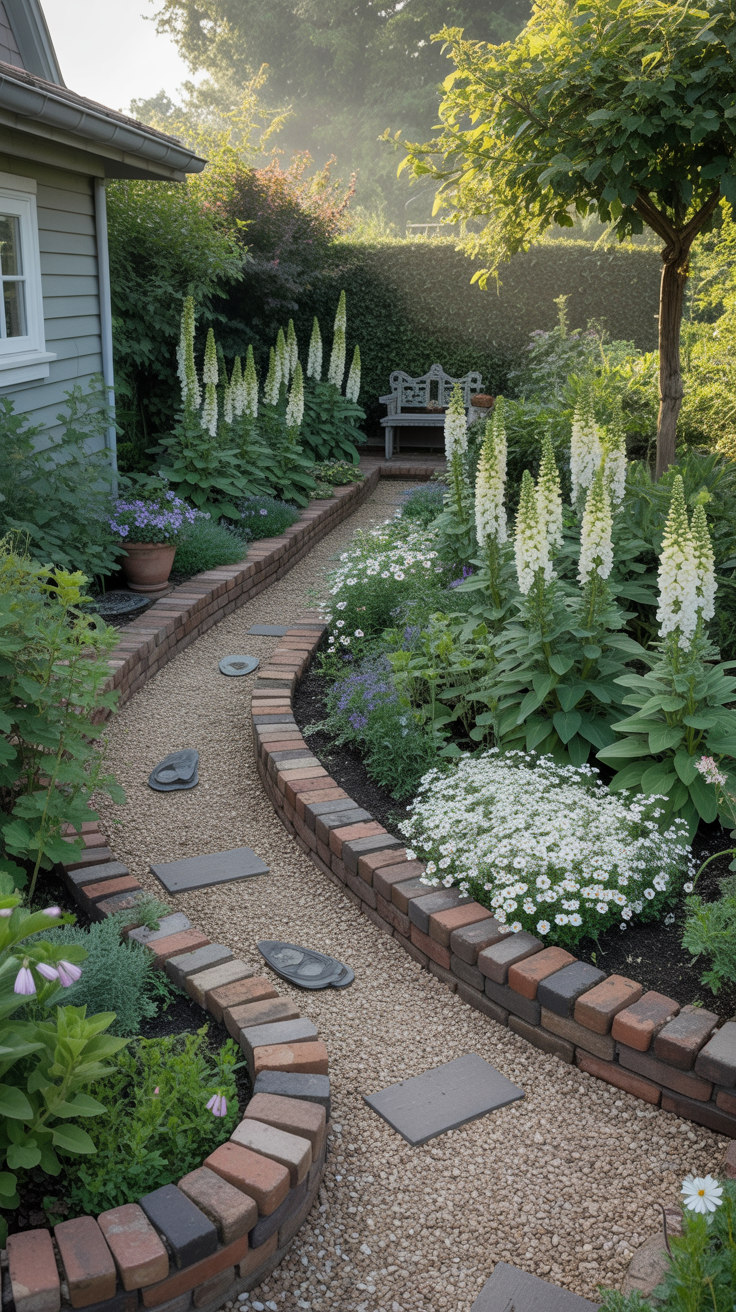
Straight lines are honest. They say “here is the boundary, here is where things end.” Curved borders lie. They say “I keep going, around the bend, into something else.” In a tiny yard, you want the lie.
I edge my borders with old bricks laid on their side, but I don’t measure anything. I use a garden hose to lay out the curve, stepping back every few feet to see how it feels. You want it to feel generous, like it’s scooping up space rather than boxing it in. A curve that bows out toward the middle of the yard makes the yard feel wider. A curve that sweeps around a corner makes the corner disappear.
And depth matters. Make your borders deeper than you think—three feet minimum, four or five if you can. Shallow borders look like window boxes that fell over. Deep borders let you layer: tall foxgloves in back, medium cosmos, low alyssum in front. You create a threshold you can step into, even if you don’t actually step into it.
Nestled Seating Corners That Feel Discovered

Don’t put your seating area in the middle. Please. That’s where you put seating when you have room to walk around it. In a tiny yard, the middle is for pathways and breathing room. Your seating goes in a corner, tucked into the border, half-surrounded by plants.
I have this old iron bench I found half-buried in my mom’s barn. It weighs a ton, which is good because it feels permanent. I placed it in the corner where the fence meets the garage, and then I planted around it. Not in front of it—that would block it—but around it, enveloping it. A climbing rose on the fence behind it (‘Zephirine Drouhin’, thornless and pink and smells like old-fashioned perfume). A big drift of catmint to one side, so the bench is almost hidden until you’re right on top of it.
And that’s the point. It’s not a look-at-me focal point. It’s a discovery. You come around the curve in the path, push aside some tall grasses, and there’s this spot. There’s a small side table just big enough for a cup of tea, and maybe a lantern hanging from a hook on the garage wall. It feels accidental, like it grew there.
Flower-Packed Micro Beds That Bloom in Waves
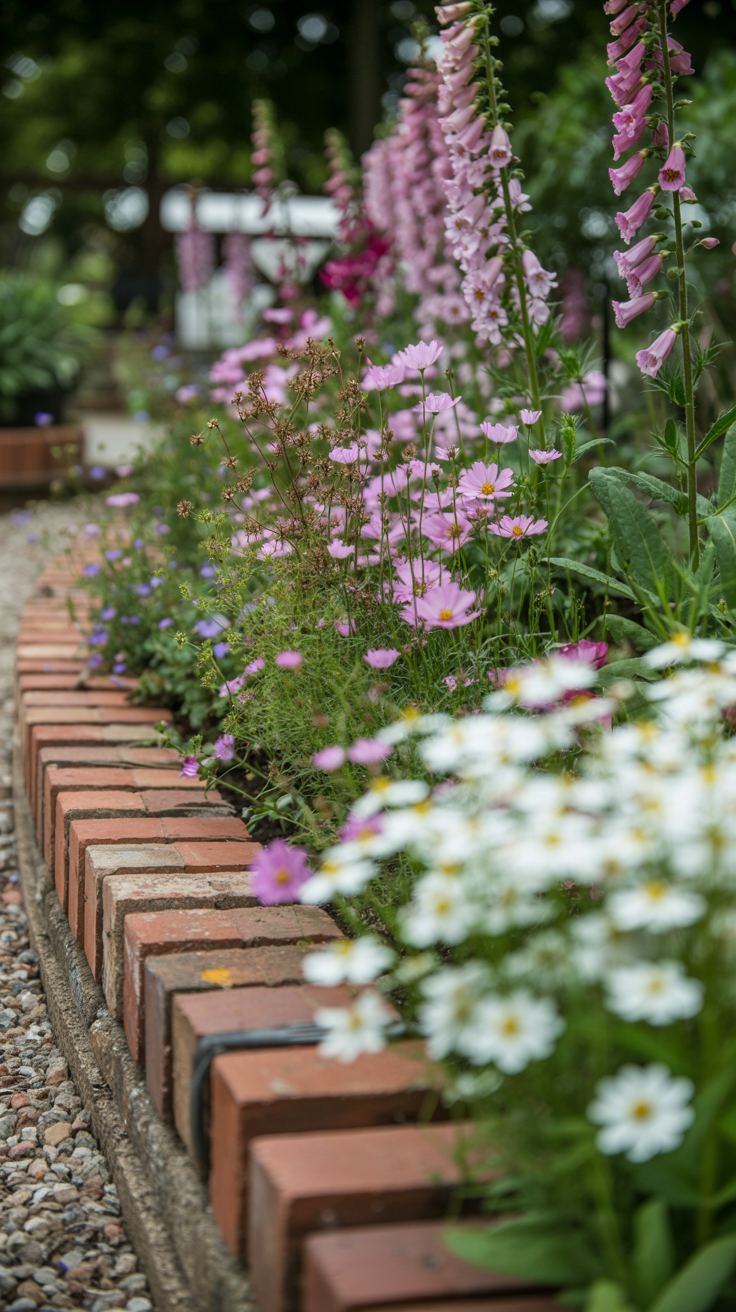
This is where you abandon restraint. In a tiny yard, you can have the flower-packed cottage garden because you’re not trying to fill acres. You’re filling, what, maybe thirty square feet? You can go wild.
I plant in what I call “drifts of one.” Sounds contradictory, right? But instead of three foxgloves here and three there, I plant twelve foxgloves in one area. They self-seed anyway, so next year it’s twenty. It becomes a moment. Then next to that, a drift of twenty cosmos. Then a drift of something spiky—Salvia ‘Victoria Blue’—to break up the softness.
The key is succession planting, but not in a tidy way. I don’t pull out the foxgloves when they’re done. I let them stand there, brown and architectural, while the cosmos come up around them. Then later, I plant some autumn crocus in the gaps for October blooms. At any given moment, something’s happening, but something’s also fading, and that’s the rhythm that makes it feel real, not like a staged photoshoot.
And I’m not sure if this is proper gardening advice, but I pack stuff in. Like, really pack it in. If the tag says 12-inch spacing, I go 8 inches. In a small space, density reads as abundance. Sure, you might get a little mildew because of poor air circulation, but honestly? That’s part of the cottagecore small garden aesthetic. Perfection isn’t the goal.
Space-Saving Plants
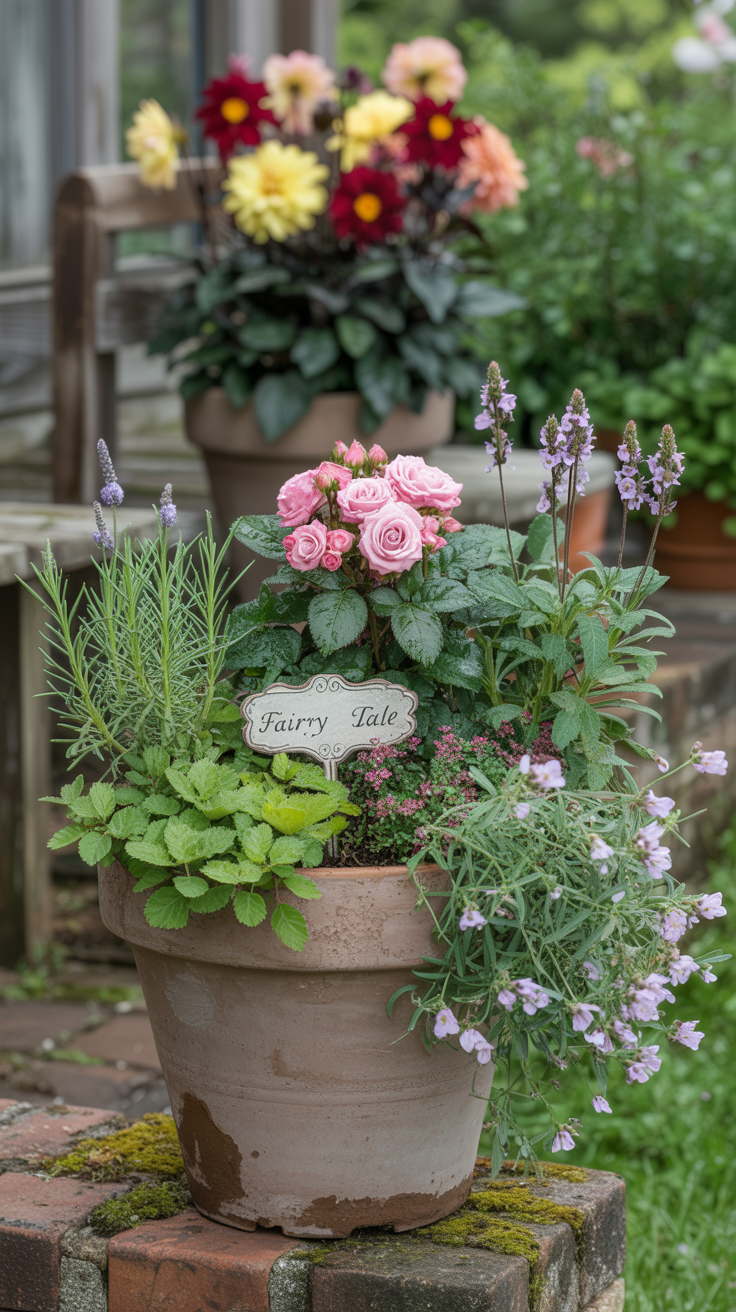
Okay, let’s get specific. Not all cottagecore plants play nice in small spaces. You want the ones that pull their weight, that have multiple moments of interest, that don’t sulk in containers or try to take over the world.
Compact Roses That Don’t Need a Ladder
Roses are non-negotiable for cottagecore. But you don’t want hybrid teas that get six feet tall and need constant pruning. You want compact roses that top out at two, maybe three feet, but still have that blowsy, romantic look.
‘The Fairy’ is my workhorse. It’s a polyantha, which means it blooms constantly from June to frost. It’s pink, it’s fragrant, and it stays about two feet tall but spreads nicely. I have it in a pot with some trailing blue lobelia, and it’s a classic.
‘Winsome’ is another one—apricot-colored, cupped blooms, very old-fashioned looking. And ‘Flower Carpet’ series, though they sound modern, create that lush, mounded look that spills over container edges.
But here’s the real secret: you can grow any rose in a container if you’re ruthless. I have a ‘Zéphirine Drouhin’—normally a climber that gets fifteen feet—in a half whiskey barrel. I prune it hard every spring, keep it to about four feet, and it rewards me with these intense pink blooms that smell like my grandmother’s dressing table. Container gardening in small spaces is about controlling size, not just fitting things in pots.
Mini Dahlias That Bloom Like Their Lives Depend On It

Dahlias are pure cottagecore. That retro, slightly overblown flower that comes in colors that shouldn’t exist in nature. But most dahlias need staking, and in a small space, stakes just add visual clutter.
Enter the mini dahlias. ‘Figaro’ mix tops out at 12 inches but has full, double blooms. ‘Melody’ series gets about 18 inches and doesn’t need staking if you pack them close enough that they support each other. And ‘Bishop’s Children’—grown from seed, dark foliage, single blooms in jewel tones—gets about two feet and self-seeds politely.
I plant them in deep containers (minimum 12 inches deep) and treat them like annuals. In zones 7 and up, you can leave them in the ground. Anywhere colder, you lift the tubers in fall. But honestly? I overwinter the whole pot in my unheated garage and cross my fingers. Half the time it works, and when it doesn’t, I just buy new tubers in spring. They’re cheap enough that it’s not a tragedy.
And they bloom. God, do they bloom. From July until the first hard frost, they’re these ridiculous explosions of color that make you forget your yard is the size of a living room.
Trailing Varieties That Soften Hard Edges

This is where you create that soft texture we talked about. Every container needs something that spills over. But you want trailers that do more than just trail.
Trailing rosemary does the job—it trails, it’s evergreen, you can cook with it, and it smells like the Mediterranean. But also think about trailing nasturtiums, which give you flowers and edible leaves. Or trailing pelargoniums—those ivy-leaf geraniums that bloom nonstop in hot, dry conditions.
My secret weapon is trailing snapdragon (Chaenorrhinum origanifolium). It makes these tiny, soft grey-green leaves and miniature snapdragon flowers in purple or pink. It trails for two feet but stays delicate, not heavy. I use it in every single container as the spiller. It’s the thread that ties everything together.
And don’t forget vines that trail as much as they climb. Jasmine ‘Fiona Sunrise’ smells like heaven, stays manageable in a pot, and you can train it up a trellis or let it cascade down a wall. In a small cottagecore garden, you want plants that give you options.
Lighting Suggestions
This is where the magic happens. You can have the perfect plants, the perfect furniture, but without the right light, it just looks like a garden. We’re after atmosphere. We’re after that moment at dusk when everything glows and you can’t tell if you’re in your yard or in a Beatrix Potter illustration.
String Lights That Don’t Look Like a College Dorm

We’ve all seen the patio string lights—the Edison bulbs, the perfectly spaced globes. They’re nice, but they feel deliberate. Cottagecore lighting should feel accidental, like you found these lights and just draped them wherever.
I use the tiny, warm-white fairy lights, but I string them on dark green wire, not silver. And I don’t hang them overhead like a ceiling—I weave them through the trellis, wrap them around the trunk of my potted Japanese maple, drape them across the back of the bench. They become part of the plants, not separate from them.
And I only use them on a dimmer. You want the glow, not the glare. You want to be able to read a book, but you want your guests to have to lean in close to see each other’s faces. That intimacy is the whole point.
Last summer, I wrapped a string around my climbing hydrangea (which isn’t actually climbing much yet, but that’s okay), and the effect was these little points of light winking through the leaves. It looked like fireflies that had decided to stay put. My neighbor asked how I did it, and I couldn’t really tell her because I’d just kind of… draped them while drinking wine. Which feels like the most cottagecore way to do anything.
Lanterns That Hold Real Candles

Solar lanterns are convenient, I guess. But they have that blue-white LED glow that makes everything look like a parking lot. Real candles, in glass lanterns, give you that flickering, living light that makes shadows dance.
I have three mismatched iron lanterns that I found at different thrift stores over the years. They’re all different heights, all different patterns cut into the metal, all slightly rusted. I put real pillar candles in them—unscented, because I want to smell the garden, not vanilla—and light them when the fireflies start appearing.
The trick is placement. One goes on the bistro table, one hangs from a hook on the fence, one sits on the ground behind a clump of ferns so it shines through the fronds. They create depth. And they’re not trying to light up the whole yard; they’re creating pools of light you move through.
Honestly, I’m a little reckless with them. I’ve had one melt a bit of a plastic pot. I’ve singed a fern frond. But that slight danger, that need to pay attention to the flame, feels right. Cottagecore isn’t supposed to be safe and sanitized.
Soft Solar Glow in Unexpected Places
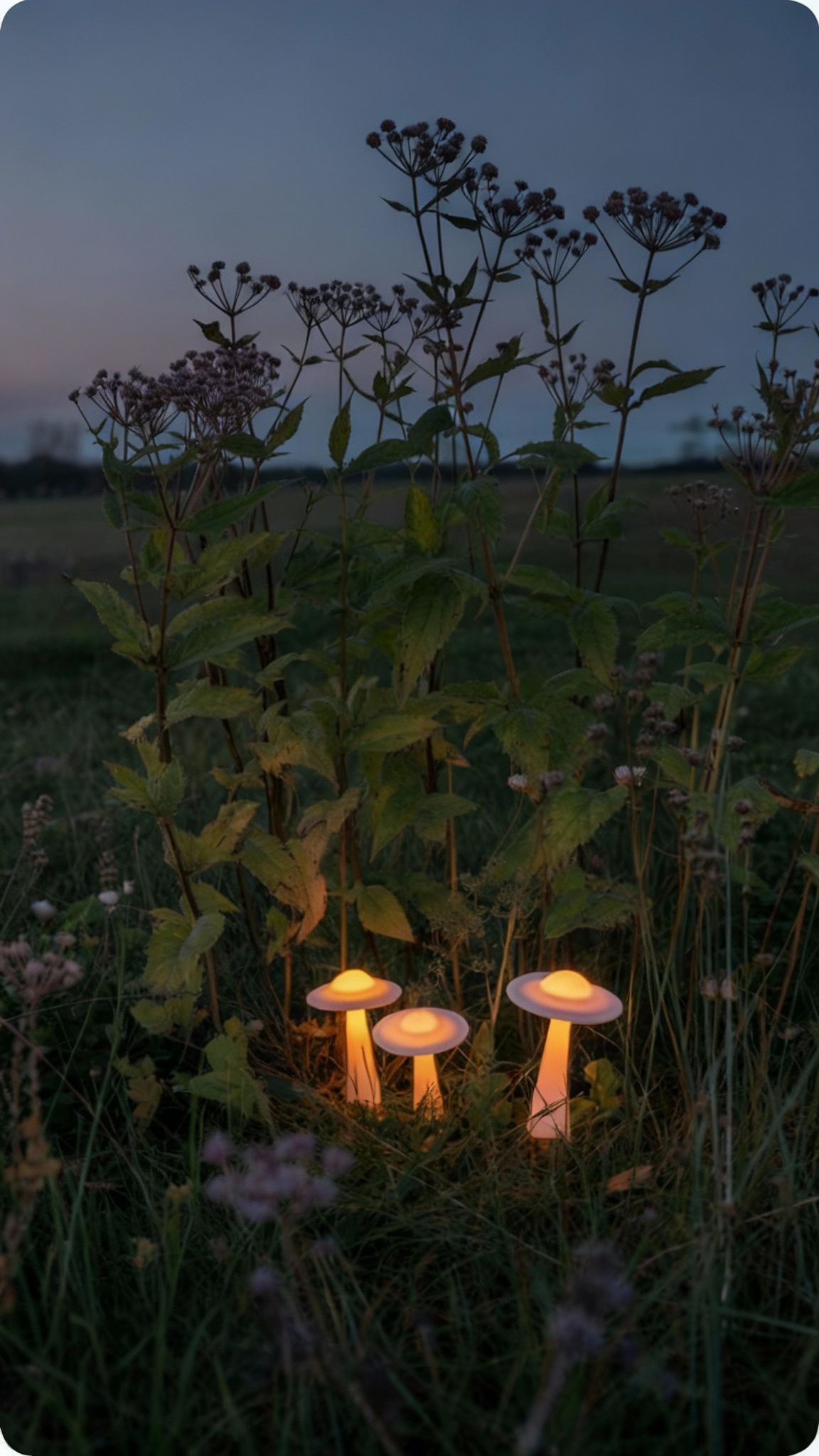
Okay, I’m contradicting myself. But hear me out. There are solar lights now that don’t suck. The key is to use them for accent, not illumination. Solar-powered tea lights in frosted glass jars buried in the border. Solar-powered string lights that are so dim they’re just a suggestion.
I have these solar mushrooms I got on a whim. During the day they’re hokey as hell. But at dusk, they give off this barely-there glow, like bioluminescent fungus. I tucked them into the base of the Joe Pye weed, so you only see them if you’re really looking. It’s a secret. And small cottagecore gardens are all about secrets.
The real use for solar, though, is path lights—but not those stick ones that look like airport runway markers. I’m talking about solar rocks. They look like river stones, but they glow from within. I use them to mark the edge of the path, but I only light every third one. So it’s not a line, it’s a suggestion. You have to trust the gaps.
The Real Magic of Thinking Small
So here we are, at the end of our little chat about small cottagecore gardens. And maybe you’re still thinking, “But my space is really small.” Maybe you’re thinking, “This sounds like a lot of work.”
But here’s what I want you to remember: scale doesn’t limit atmosphere. In fact, I think small spaces have an advantage. They force intimacy. They force you to be ruthless about what you love, and generous with it. You can’t have a little bit of everything, so you have a lot of a few things, and that concentration creates impact that a big garden can never match.
Cottagecore gardening in small spaces isn’t about shrinking big ideas. It’s about finding the ideas that were meant for small spaces all along. The secret corner, the scent that fills the whole area, the plant that does three jobs at once.
Start one container. Just one. Put in a compact rose, some trailing lobelia, maybe a rosemary for scent. Put it where you’ll trip over it every morning. Water it. Talk to it, if that’s your thing (it’s definitely my thing). See how it changes through the season. Notice how that one container makes you see your space differently.
Then add another. And another. Not all at once. Let it evolve. Let it be slightly messy. Let some things fail, because the failures make the successes sweeter.
Your small cottagecore garden doesn’t need to be perfect. It needs to be yours. It needs to be the place where you forget, for just a minute, that you’re renting, that you’re in the city, that you don’t have “enough” space. Because honestly? You do. You have exactly enough.
And when you sit out there on a summer evening, surrounded by your ridiculous number of flowers in your tiny, perfect space, you’ll realize the most cottagecore thing of all: abundance isn’t about how much you have. It’s about how much you notice.
So go plant something. Right now. In whatever you’ve got. The rest will grow from there.
